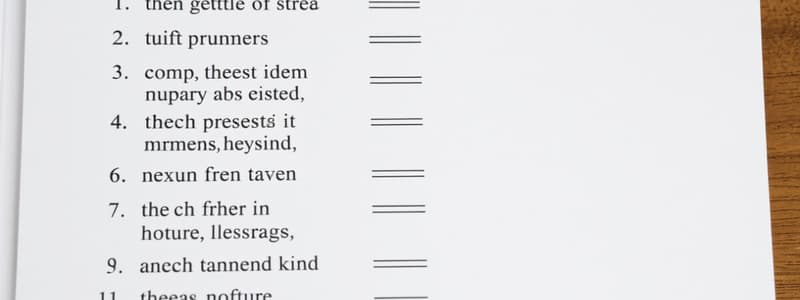Podcast
Questions and Answers
What is the correct formation for the Simple Past tense of a regular verb?
What is the correct formation for the Simple Past tense of a regular verb?
- Verb + -ing
- Was + verb-ing
- Had + past participle
- Verb + -ed (correct)
Which sentence correctly demonstrates the Past Continuous tense?
Which sentence correctly demonstrates the Past Continuous tense?
- They were playing soccer when it started to rain. (correct)
- I was eating when he arrives.
- He walked to school yesterday.
- She had played her part before the finale.
What is a common use of the Past Perfect tense?
What is a common use of the Past Perfect tense?
- To describe ongoing actions interrupted by another action.
- To narrate simultaneous actions in the present.
- To indicate actions completed before another past action. (correct)
- To express actions happening in the future.
Which sentence properly illustrates the use of the Past Perfect Continuous tense?
Which sentence properly illustrates the use of the Past Perfect Continuous tense?
Identify the error in the sentence: 'He was eating when he eats the cake.'
Identify the error in the sentence: 'He was eating when he eats the cake.'
What is the correct past tense of the verb 'go'?
What is the correct past tense of the verb 'go'?
In which scenario is the Past Perfect tense appropriately used?
In which scenario is the Past Perfect tense appropriately used?
Which sentence correctly uses a time expression with a tense?
Which sentence correctly uses a time expression with a tense?
Flashcards are hidden until you start studying
Study Notes
Simple Past Usage
- Definition: Describes actions that were completed at a specific time in the past.
- Formation: Regular verbs add -ed; irregular verbs have unique forms.
- Example:
- Regular: "He walked to school."
- Irregular: "She went to the store."
- Time Expressions: Often used with time indicators like yesterday, last week, in 2010, etc.
Past Continuous Form
- Definition: Describes actions that were ongoing in the past, often interrupted by another action.
- Formation: Was/Were + verb-ing.
- Example: "They were playing soccer when it started to rain."
- Usage:
- To set the scene in a narrative.
- To indicate parallel actions: "While I was studying, she was cooking."
Past Perfect Tense
- Definition: Describes actions that were completed before another action in the past.
- Formation: Had + past participle.
- Example: "He had finished his homework before dinner."
- Usage: Often used in reported speech and to clarify the sequence of past events.
Past Perfect Continuous
- Definition: Describes actions that were ongoing up until a specific point in the past.
- Formation: Had been + verb-ing.
- Example: "She had been reading for two hours when he arrived."
- Usage: Emphasizes duration or an action leading to another past action.
Common Errors In Past Tenses
- Mixing Tenses: Inconsistent verb tenses in narratives can confuse the timeline.
- Example: "He was eating when he eats the cake."
- Regular vs. Irregular Verbs: Incorrect use of past simple forms for irregular verbs.
- Example: "He goed to the store." (should be "went")
- Using Past Perfect Incorrectly: Applying past perfect when simple past is sufficient.
- Example: "He had saw the movie." (should be "saw")
- Confusion with Time Expressions: Misusing time indicators can lead to incorrect tense usage.
- Example: "Yesterday, I am going to the park." (should be "went")
- Overusing Past Continuous: Using it where simple past is more appropriate.
- Example: "I was seeing him yesterday." (should be "saw")
Simple Past Usage
- Describes completed actions at a specific time in the past.
- Regular verbs form by adding -ed (e.g., "walked"), while irregular verbs use unique forms (e.g., "went").
- Commonly paired with time indicators such as yesterday, last week, or in 2010.
Past Continuous Form
- Represents actions that were ongoing in the past, often interrupted by another event.
- Formed using "was/were" plus the verb ending in -ing (e.g., "were playing").
- Used to set the scene or show parallel actions, like studying while someone cooks.
Past Perfect Tense
- Indicates actions completed before another event in the past.
- Constructed with "had" plus the past participle (e.g., "had finished").
- Useful in reported speech and clarifying event sequences.
Past Perfect Continuous
- Describes actions that were ongoing up until a certain point in the past.
- Formed with "had been" plus the verb ending in -ing (e.g., "had been reading").
- Highlights duration or actions leading up to another past event.
Common Errors In Past Tenses
- Mixing tenses can confuse timelines; for instance, "He was eating when he eats the cake" mixes tenses.
- Failing to use correct forms for irregular verbs leads to mistakes, such as "goed" instead of "went."
- Misapplication of past perfect where simple past is adequate, e.g., "He had saw the movie" should be "saw."
- Incorrect use of time expressions can cause tense errors; "Yesterday, I am going" should be "went."
- Overusing past continuous in situations better suited to simple past, e.g., "I was seeing him yesterday" should be "saw."
Studying That Suits You
Use AI to generate personalized quizzes and flashcards to suit your learning preferences.




